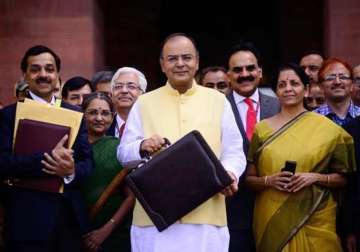10 industry expectations from Union Budget 2016-17
New Delhi: With the Union Budget for 2016-17 scheduled to be presented by Finance Minister Arun Jaitley on February 29, expectations are high that the government may walk an extra mile to improve the investment

New Delhi: With the Union Budget for 2016-17 scheduled to be presented by Finance Minister Arun Jaitley on February 29, expectations are high that the government may walk an extra mile to improve the investment activity in the country to boost the overall economy. The Budget for this year will be keenly watched, perhaps even more closely than its earlier editions.
The expectations from the government are varied and predictions on the roadmap that the government has in mind for the coming financial year difficult. Industry experts, meanwhile, are pitching for a growth-oriented Budget; one that addresses its concerns as well as its long-pending demands.
Industry will be looking for measures that can provide a significant boost to economic sentiment to kick-start stalled investments.
Economists surveyed by FICCI have said that the Budget must strengthen the domestic capital expenditure cycle towards boosting growth. The economists surveyed said that they look forward to the government sticking to the path towards fiscal consolidation; but not at the cost of curtailing productive expenditure.
Here are 10 major expectation that industry has from the Budget 2016-17:
1. Higher public expenditure: Industry experts believe that the Budget needs to find a middle path between expenditure and fiscal consolidation given the current fiscal parameters and other constraints that the economy is facing as of now.
On one hand, it is essential for the government to increase capital expenditure and infrastructure spending in order to spur investments.
On the other, it needs to keep its goals regarding fiscal deficit in mind while planning things. Some strong economic indicators and the drop in crude oil prices could spur government spending, provided it considers meeting its fiscal deficit target of 3.5 per cent of GDP for FY2017 partially.
2. Most c-suite executives feel that efforts should be made to not only maintain the 7.6 per cent growth rate but also improve upon it.
They believe that India could look for growth rates of anything between 8-9 per cent of the growth rate, rather than just maintaining the current levels.
India's revised growth numbers have placed India as the fastest growing economy and there are high expectations from the Modi government, which rode to power with the promise to usher in economic growth.
With the oil windfall will help the government meet its target of reigning in the fiscal deficit to below 3.9 per cent, the policies and measures announced by the government tax holidays, incentives etc will be crucial for the future course of the economy.
3. The fiscal consolidation roadmap has targeted to keep the fiscal deficit at 3.9 per cent of the GDP in 2015-16, and lower it to 3.6 per cent next fiscal.
However, the industry expects the fiscal deficit targets to be relaxed for one more year to boost growth by higher capital spending. Much of this demand stems from favourable conditions for India at the moment especially when compared to most countries around the world.
Increased public spending will not only draw much needed investments, it will also boost domestic demand and spending.
4. A roadmap for the implementation of GST is long expected by the industry to bring transparency in taxation and avoid many duplicities in the system.
The biggest challenge for the government, however, is to get it passed in the upper house of the parliament and bring all state governments on the table.
Besides GST, which has been a sticking point between the government and the Congress, other laws such as those on land and labour have led to a situation where investments have not matched desired results.